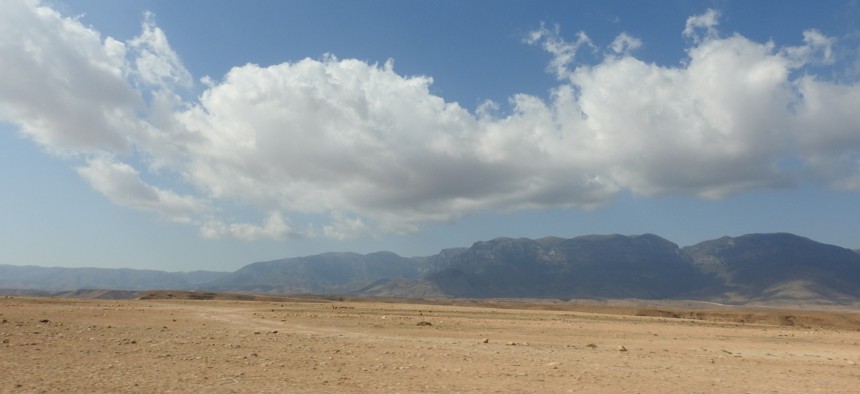Cloud-based 911 for faster emergency response

Hussain Muthaffar / EyeEm via Getty Images
With its interactive emergency communication response platform and access to a location data clearinghouse, the Rio Grande Council of Governments can speed help to 911 callers, even if they don’t know where they are.
It used to be that people stranded in the desert of western Texas started fires to draw attention to their location. Since February, however, anyone lost in the vast jurisdiction of the Rio Grande Council of Governments (RIOCOG), which covers 25,516 square miles, can call 911 and show a picture of exactly where they are.
“Because we’re positioned right on the U.S./Mexico border, we do have a lot of migrants coming over not knowing the language, not knowing where they’re at; they’re lost,” said Marisa Quintanilla, regional services director at RIOCOG. “There’s no [way] to say, ‘I’m by this fire station,’ ‘I’m by the water tower’ or anything like that. For them to be able to click on the link and show their camera, and to see where they’re at and provide that to the dispatcher, to the call taker, that is huge. Then that call taker can go ahead and provide the precise location of that individual to provide them emergency services.”
Powering that capability is a fully cloud-based 911 contact center that uses Carbyne’s APEX, a secure, interactive emergency communication response platform for public safety and call management. The company has partnered with Amazon Web Services’ GovCloud and RapidSOS, which provides a free clearinghouse of location and other real-time data to public safety organizations.
The integration allows call takers to send a link for callers to click to share their screen or provide photos, videos and other geolocation and situation information that dispatchers can give to responders. The result is faster response – and emergency crews arriving equipped with the right tools to handle the incident.
For instance, during a pilot test of APEX in Georgia, the average time to locate callers fell from 23 minutes to three minutes.
Although Amir Elichai, Carbyne founder and CEO, said there are no connectivity requirements to use APEX, RIOCOG upgraded some circuits and increased bandwidth to maximize its capabilities. It also implemented better routers to be able to receive the data associated with calls.
Other APEX features include real-time transcription, or speech-to-text capabilities; live closed-captioning; and predefined help requests. By the end of this quarter, RIOCOG will start testing language translation, with a plan for it to go live in the last quarter of the year.
“The biggest challenge that we faced for many years was basically that we did not have the technology infrastructure to be able to provide accurate call information as well as reliable caller information,” Quintanilla said. “Also … all of our 911 equipment was still on the legacy network, meaning that you still had the hardware, the big boxes, the big servers to be able to deliver that 911 call.”
That also meant that when something failed at one of RIOCOG’s five rural public safety answering points (PSAPs), staff had to wait for a technician to get out there.
Moving to the cloud means the PSAPs can now automatically reroute calls to another location if one goes down. It also means that RIOCOG retired some of those legacy systems and their associated recurring costs, saving the organization $200,000 a year.
The migration came about when the Commission on State Emergency Communications, RIOCOG’s funding agency, asked the group to move to an i3 platform, designed to provide accurate caller and location information, and to transition to the Emergency Services IP Network, or ESInet, which supports Next Generation 911. RIOCOG’s vendor at the time was unable to support those changes, and Quintanilla discovered APEX in researching other options.
“It’s amazing to be able to deploy these services, to have those capabilities to deploy those first responders to be able to save people’s lives,” Quintanilla said.
RIOCOG is the first organization in Texas to adopt APEX. The Orleans Parish Communication District in Louisiana also uses APEX for 911 response, but Carbyne’s Elichai said another 14 deployments will come online this year nationwide, including some Global Medical Response sites. GMR is the largest emergency management system provider in the United States.
In July, Carbyne and GMR launched Bridge Desk, a distributed asset management solution that aggregates multiple data sources into one unified geographic information system.
“This gives the GMR senior leadership full-time awareness of all their assets that are distributed throughout the country, from ambulances to … planes that are being distributed for a national disaster,” Elichai said.
Additionally, GMR will replace legacy solutions at its 65 contact centers with APEX – starting with five this year – giving the organization the ability to work on and maintain a single environment.
“This is the way for the future. Eventually this is going to be mandated that all public safety answering points have this capability,” Quintanilla said.
Stephanie Kanowitz is a freelance writer based in northern Virginia.





